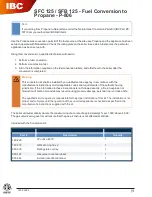
1
General safety precautions
Installation and operating instructions
6
Daikin/ROTEX A2 F
Oil condensing boiler A2 F
008.1546499_02 – 04/2018 – EN
Any other use outside the intended use is considered as improper
and will result in a loss of warranty. The operator alone shall bear re-
sponsibility for any resulting damage.
The A2 F is suitable for operation with light heating oil.
Intended use also includes compliance with the maintenance and
service conditions. Replacement parts must at least satisfy the tech-
nical requirements defined by the manufacturer. This is the case,
for example, with original spare parts.
1.2.3
Device installation room
▪ Operate A2 F only if sufficient combustion air supply is ensured. If
the A2 F is operated as an ambient air-independent device with a
concentric air/flue gas system (LAS) dimensioned according to the
manufacturer's standard, this is automatically ensured and there
are no further conditions for the installation room. Only this
method of operation is permissible for installation in residential
rooms.
▪ Make sure that there is an outside air opening of at least 150 cm
2
for ambient-air dependent or partial ambient-air independent oper-
ation.
▪ Do not operate the A2 F in ambient-air dependent operation in
rooms with aggressive vapours (e.g. hair spray, perchloroethyl-
ene, carbon tetrachloride), strong dust formation (e.g. workshop)
or high humidity (e.g. laundries).
▪ Avoid operating conditions that can cause heavy soiling of the
burner. Do not operate the device if temporary heavy dust depos-
its occur in the area of the air extraction system.
▪ Always ensure the minimum distances to walls and other objects
(see
Chap. 4.4.1
).
1.2.4
Electrical installation
▪ Electrical installations may only be carried out by electrical techni-
cians and in compliance with valid electrical guidelines as well as
the specifications of the responsible energy supply company.
▪ Compare the mains voltage (230 V, 50 Hz) indicated on the name-
plate with the supply voltage before connecting to the mains.
▪ Before beginning work on live parts, disconnect them from the
power supply (switch off main switch, remove fuse) and secure
against unintentional restart.
▪ Device covers and service panels must be replaced as soon as
the work is completed.
1.2.5
Requirements for the heating water
Avoid damage caused by deposits and corrosion: Comply with the
applicable engineering regulations on prevention of corrosion
products and deposits (VDI 2035, BDH/ZVSHK technical information
"Scale formation").
Measures for desalination, softening or hardness stabilisation are
necessary if the filling and top-up water have a high total hardness
(>3 mmol/l - total of the calcium and magnesium concentrations, cal-
culated as calcium carbonate).
Minimum requirements regarding the quality of filling and supple-
mentary water:
▪ Water hardness (calcium and magnesium, calculated as calcium
carbonate): ≤ 3 mmol/l
▪ Conductivity: ≤ 1500 (ideal: ≤ 100) μS/cm
▪ Chloride: ≤ 250 mg/l
▪ Sulphate: ≤ 250 mg/l
▪ pH-values (heating water): 6.5 - 8.5
Measures for desalination, softening or hardness stabilisation or
other suitable conditioning measures are necessary to maintain the
required water quality if the filling and top-up water have a high total
hardness or other properties divergent from the minimum require-
ments.
Using filling water and top-up water which does not meet the stated
quality requirements can cause a considerably reduced service life
of the device. The responsibility for this lies solely with the operator.
1.2.6
Heating system and sanitary connection
▪ Create a heating system according to the safety requirements of
EN 12828.
▪ The sanitary connection for filling the system from the drinking wa-
ter supply network and for connection of a hot water tank must
meet the requirements of EN 12897. The requirements of the fol-
lowing must also be observed:
▪ EN 1717 – Protection against pollution of potable water installa-
tions and general requirements of devices to prevent pollution
by backflow
▪ EN 61770 – Electric appliances connected to the water mains –
Avoidance of backsiphonage and failure of hose-sets
▪ EN 806 – Specifications for installations inside buildings con-
veying water for human consumption
▪ and, in addition, the country-specific legislation.
1.2.7
Fuel
The A2 F is intended exclusively for the use of approved heating oils
(see
Chap. 12
).
1.2.8
Operation
▪ Do not operate the A2 F if the boiler cladding is open.
▪ Only operate the A2 F if all requirements according to the check-
list in
Chap. 5.2
are satisfied.







































